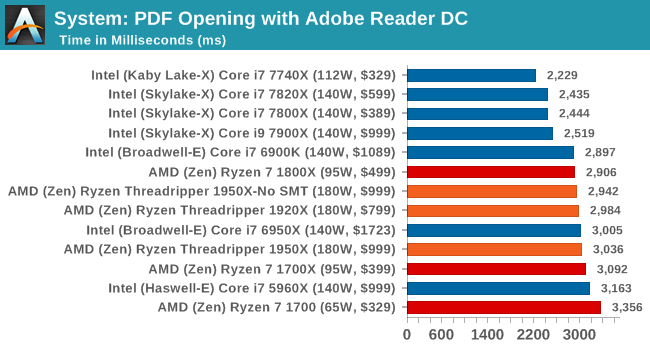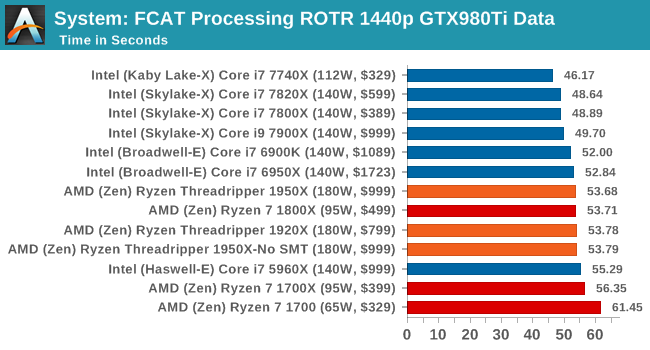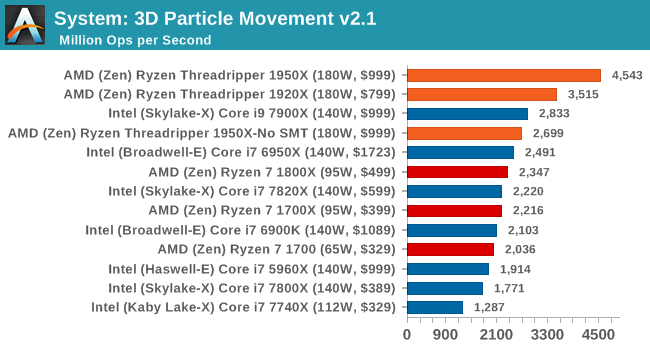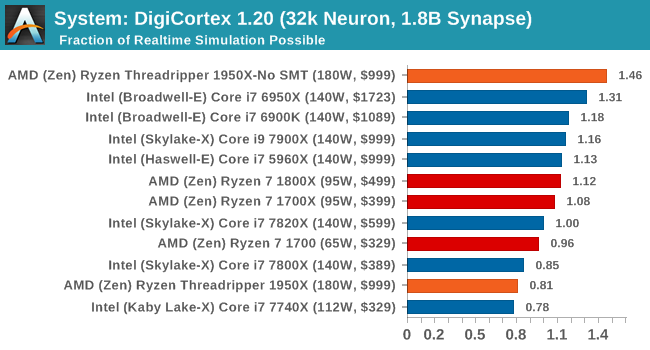The AMD Ryzen Threadripper 1950X and 1920X Review: CPUs on Steroids
by Ian Cutress on August 10, 2017 9:00 AM ESTCPU System Tests
Our first set of tests is our general system tests. These set of tests are meant to emulate more about what people usually do on a system, like opening large files or processing small stacks of data. This is a bit different to our office testing, which uses more industry standard benchmarks, and a few of the benchmarks here are relatively new and different.
All of our benchmark results can also be found in our benchmark engine, Bench.
PDF Opening
First up is a self-penned test using a monstrous PDF we once received in advance of attending an event. While the PDF was only a single page, it had so many high-quality layers embedded it was taking north of 15 seconds to open and to gain control on the mid-range notebook I was using at the time. This put it as a great candidate for our 'let's open an obnoxious PDF' test. Here we use Adobe Reader DC, and disable all the update functionality within. The benchmark sets the screen to 1080p, opens the PDF to in fit-to-screen mode, and measures the time from sending the command to open the PDF until it is fully displayed and the user can take control of the software again. The test is repeated ten times, and the average time taken. Results are in milliseconds.

This opening test is single threaded, so the high-frequency Intel parts get a clear win. There's not much between the Threadripper CPUs here.
FCAT Processing: link
One of the more interesting workloads that has crossed our desks in recent quarters is FCAT - the tool we use to measure and visually analyze stuttering in gaming due to dropped or runt frames. The FCAT process requires enabling a color-based overlay onto a game, recording the gameplay, and then parsing the video file through the analysis software. The software is mostly single-threaded, however because the video is basically in a raw format, the file size is large and requires moving a lot of data around. For our test, we take a 90-second clip of the Rise of the Tomb Raider benchmark running on a GTX 980 Ti at 1440p, which comes in around 21 GB, and measure the time it takes to process through the visual analysis tool.

Similar to PDF opening, single threaded performance wins out.
Dolphin Benchmark: link
Many emulators are often bound by single thread CPU performance, and general reports tended to suggest that Haswell provided a significant boost to emulator performance. This benchmark runs a Wii program that ray traces a complex 3D scene inside the Dolphin Wii emulator. Performance on this benchmark is a good proxy of the speed of Dolphin CPU emulation, which is an intensive single core task using most aspects of a CPU. Results are given in minutes, where the Wii itself scores 17.53 minutes.

Dolphin likes single thread performance as well, although having some cores to back it up seems to be required.
3D Movement Algorithm Test v2.1: link
This is the latest version of the self-penned 3DPM benchmark. The goal of 3DPM is to simulate semi-optimized scientific algorithms taken directly from my doctorate thesis. Version 2.1 improves over 2.0 by passing the main particle structs by reference rather than by value, and decreasing the amount of double->float->double recasts the compiler was adding in. It affords a ~25% speed-up over v2.0, which means new data.

Our first pure multithreaded test, and the 1950X wins with 32 threads. The 1920X beats the 1950X in SMT-off mode, due to 24 threads beating 16 threads.
DigiCortex v1.20: link
Despite being a couple of years old, the DigiCortex software is a pet project for the visualization of neuron and synapse activity in the brain. The software comes with a variety of benchmark modes, and we take the small benchmark which runs a 32k neuron/1.8B synapse simulation. The results on the output are given as a fraction of whether the system can simulate in real-time, so anything above a value of one is suitable for real-time work. The benchmark offers a 'no firing synapse' mode, which in essence detects DRAM and bus speed, however we take the firing mode which adds CPU work with every firing.

DigiCortex requires a mash of CPU frequency and DRAM performance to get a good result, and anything with quad-channel memory is usually preferred. The 1950X in SMT-off mode wins here due to its low main memory latency combined with having 16 threads to access it. The Broadwell-E is the nearest competitor, over Skylake-X, most likely due to the mesh vs ring topology. The 1950X in Creator mode scores way down the field however, lower than the standard Ryzen chips, showing that under a unified memory architecture there can be significant performance drops. The 1920X failed in this test for an unknown reason.
Agisoft Photoscan 1.0: link
Photoscan stays in our benchmark suite from the previous version, however now we are running on Windows 10 so features such as Speed Shift on the latest processors come into play. The concept of Photoscan is translating many 2D images into a 3D model - so the more detailed the images, and the more you have, the better the model. The algorithm has four stages, some single threaded and some multi-threaded, along with some cache/memory dependency in there as well. For some of the more variable threaded workload, features such as Speed Shift and XFR will be able to take advantage of CPU stalls or downtime, giving sizeable speedups on newer microarchitectures.

The variable threaded nature of Agisoft shows that in our workflow, it's a mix of cores, IPC and frequency required to win. AMD takes a back seat here, likely due to its AVX implementation.










347 Comments
View All Comments
Ian Cutress - Thursday, August 10, 2017 - link
Anand hasn't worked at the website for a few years now. The author (me) is clearly stated at the top.Just think about what you're saying. If I was in Intel's pocket, we wouldn't be being sampled by AMD, period. If they were having major beef with how we were reporting, I'd either be blacklisted or consistently on a call every time there's been an AMD product launch (and there's been a fair few this year).
I've always let the results do the talking, and steered clear from hype generated by others online. We've gone in-depth into the how things are done the way they are, and the positives and negatives as to the methods of each action (rather than just ignoring the why). We've run the tests, and been honest about our results, and considered the market for the product being reviewed. My background is scientific, and the scientific method is applied rigorously and thoroughly on the product and the target market. If I see bullshit, I point it out and have done many times in the past.
I'm not exactly sure what you're problem is - you state that the review is 'slanted journalism', but fail to give examples. We've posted ALL of our review data that we have, and we have a benchmark database for anyone that ones to go through all the data at any time. That benchmark database is continually being updated with new CPUs and new tests. Feel free to draw your own conclusions if you don't agree with what is written.
Just note that a couple of weeks ago I was being called a shill for AMD. A couple of weeks before that, a shill for Intel. A couple before that... Nonetheless both companies still keep us on their sampling lists, on their PR lists, they ask us questions, they answer our questions. Editorial is a mile away from anything ad related and the people I deal with at both companies are not the ones dealing with our ad teams anyway. I wouldn't have it any other way.
MajGenRelativity - Thursday, August 10, 2017 - link
I personally always enjoy reading your reviews Ian. Even though they don't always reach the conclusions I hoped they would reach before reading, you have the evidence and benchmarks to back it up. Keep up the good work!Diji1 - Thursday, August 10, 2017 - link
Agreed!Zstream - Thursday, August 10, 2017 - link
For me, it isn't about "scientific benchmarking", it's about what benchmarks are used and what story is being told. I think, along with many others, would never buy a threadripper to open a single .pdf. I could be wrong, but I don't think that's the target audience Intel or AMD is aiming for.I mean, why not forgo the .pdf and other benchmarks that are really useless for this product and add multi-threaded use cases. For instance, why not test how many VM's and I/O is received, or launching a couple VM's, running a SQL DB benchmark, and gaming at the same time?
It could just be me, but I'm not going to buy a 7900x or 1950x for opening up .pdf files, or test SunSpider/Kraken lol. Hopefully we didn't include those benchmarks to tell a story, as mentioned above.
We're goingto be compiling, 3d rendering with multi-gpu's, running multiple VM's, all while multi-tasking with other apps.
My 2 cents.
DanNeely - Thursday, August 10, 2017 - link
Single threaded use cases aren't why people buy really wide CPUs. But performing badly in them, since they represent a lot of ordinary basic usage, can be a reason not to buy one. Also running the same benches on all products allows for them all to be compared readily vs having to hunt for benches covering the specific pair you're interested in.VM type benchmarks are more Johan's area since that's a traditional server workload. OTOH there's a decent amount of overlap with developer workloads there too so adding it now that we've got a compile test might not be a bad idea. On the gripping hand, any new benchmarks need to be fully automated so Ian can push an easy button to collect data while he works on analysis of results. Also the value of any new benchmark needs to be weighed against how much it slows the entire benching run down, and how much time rerunning it on a large number of existing platforms will take to generate a comparison set.
iwod - Thursday, August 10, 2017 - link
It really depends on use case. 20% slower on PDF opening? I dont care, because the time has reached diminishing returns and Intel needs to be MUCH faster for this to be a UX problem.But I think at $999 Intel has a strong case for its i9. But factoring in the MB AMD is still cheaper. Not sure if that is mentioned in the article.
Also note Intel is on their third iteration of 14nm, against a new 14nm from AMD GloFlo.
I am very excited for 7nm Zen 2 coming next year. I hope all the software and compiler as well as optimisation has time to catch up for Zen.
Zstream - Thursday, August 10, 2017 - link
I won't get into an argument, but I and many of my friends, who are on the developer side of the house have been waiting for this review, and it doesn't provide me with any useful information. I understand it might be Johan's wheelhouse, but come on... opening a damn .pdf file, and testing SunSpider/Kraken/gaming benchmarks? That won't provide anyone interested in either CPU any validation of purchase. I'm not trying to be salty, I just want some more damn details vs. trying to put both vendors in a good light.Ian Cutress - Thursday, August 10, 2017 - link
Rather than have 20 different tests for each set of different CPUs and very minimal overlap, we have a giant glove that has all the tests for every CPU in a single script. So 80 test points, rather than 4x20. The idea is that there are benchmarks for everyone, so you can ignore the ones that don't matter, rather than expect 100% of the benchmarks to matter (e.g. if you care about five tests, does it matter to you if the tests are published alongside 75 other tests, or do they have to be the only five tests in the review?). It's not a case of trying to put both vendors in a good light, it's a case of this is a universal test suite.Zstream - Thursday, August 10, 2017 - link
Well, show me a database benchmark, virtual machine benchmark, 3dmax benchmark, blender benchmark and I'll shutty ;)It's hard for me to look at this review outside of a gamers perspective, which I'm not. Sorry, just the way I see it. I'll wait for more pro-consumer benchmarks?
Johan Steyn - Thursday, August 10, 2017 - link
This is exactly my point as well. Why on earth so much focus on single threaded tests and games, since we all knew from way back TR was not going to be a winner here. Where are all the other benches as you mention. Oh, no, this will have Intel look bad!!!!!